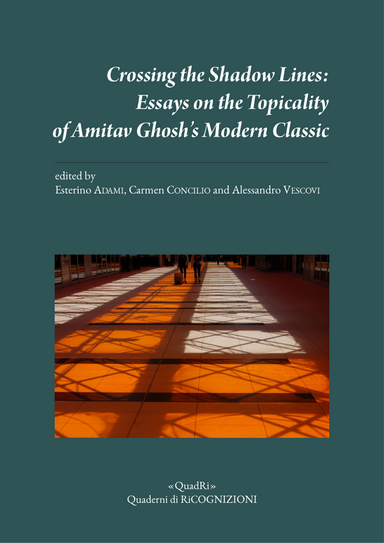V. 11 (2020): Esterino Adami, Carmen Concilio, Alessandro Vescovi (eds), «Crossing the Shadow Lines : Essays on the Topicality of Amitav Ghosh’s Modern Classic», Dipartimento di Lingue e Letterature Straniere e Culture Moderne – Università degli Studi di Torino, Torino 2020

Amitav Ghosh’s second novel, The Shadow Lines (1988), was notoriously conceived in 1984, in the aftermath of Indira Gandhi’s assassination, when Delhi was upturned by bloodthirsty mobs that attacked the Sikh community killing, raping, and looting. This was the “madeleine” that brought the would-be novelist (he was halfway through writing The Circle of Reason) back to 1964, when a similar mob attacked Hindus in Dhaka, where Ghosh, then a child, was living with his family. Thus The Shadow Lines became a historical novel about Bengal in the Sixties, a portrait of post-Independence India, a Bildungsroman, or indeed a Künstlerroman, about a young Bengali, an Indian reply to both Portrait of the Artist as a Young Man (1915) and Remembrance of Time Past (1922) that enthused a generation of Indian intellectuals. Indeed, The Shadow Lines is the first and so far only novel by a living author to be included in University syllabi all over India. Unsurprisingly this is, among Ghosh’s books, the most written about, especially in South Asia. The Shadow Lines has gained enormous resonance in postcolonial studies as it touches upon some of the major issues in the fields of colonial history, national identities, memory, and borders. Likewise, the novel has been seminal in the definition and discussion of a postcolonial geography that challenges the current cartographical order. It has drawn from the literary tradition of the past and has influenced new literary productions, as the variety of international scholarly essays in this collection demonstrate.
InTRODUCTION: Esterino ADAMI, Carmen CONCILIO, Alessandro VESCOVI • The Topicality of The Shadow Lines. Bordering Texts and Foreshadowed Contexts; Amitav GHOSH • A Letter Sent to the Partecipants in The Shadow Lines Thirty Years After
I. BoRDERING TeXTS: Supriya CHAUDHURI • The Absence of a Hyphen: Borders, Crossings, Identities in The Shadow Lines; Alessandro VESCOVI • The Shadow Lines as a Work in Progress. A Genetic Approach to some Pages from the Typescript; Eleonora SPARVOLI • “An Alternative Modernism”: Proust’s Lesson in The Shadow Lines; Vishnupriya SENGUPTA • Polemics of Nationhood: A Study of Amitav Ghosh’s Shadow Lines and V.S. Naipaul’s The Mimic Men; Federica ZULLO • The Language of Violence and Fear in The Shadow Lines. A Stylistic Analysis; Asis DE and Nirmalendu MAITI • Shadow Lines: The Border, the “Other”, and the Eco-literary in The Hungry Tide and The Great Derangement; Lucio DE CAPITANI • Riots, Crowds and the Collective in Amitav Ghosh’s Political Imagination. From The Shadow Lines to Gun Island
II. FoRESHADOWED CoNTEXTS: John THIEME • Through the Looking Glass: Sameness and Difference in The Shadow Lines; Silvia ALBERTAZZI • Maps, Houses, and Shadow Lines: Amitav Ghosh’s Masterpiece Thirty Years After; Binayak ROY • The Shadow Lines and the Dialogism of Adda; Carmen CONCILIO • Borderless Ageing. A Reading of Amitav Ghosh’s The Shadow Lines face to face with Caterina Edward’s Finding Rosa. What History Teaches and Geography Cannot Learn; Francesca ORSINI • Significant Geographies in The Shadow Lines; Sumit RAY • The Bengali bhadralok as World-traveller in The Shadow Lines; Anna NADOTTI • Quasi trent’anni dopo la traduzione di The Shadow Lines
* * *
Esterino Adami, Carmen Concilio, Alessandro Vescovi (eds), Crossing the Shadow Lines : Essays on the Topicality of Amitav Ghosh’s Modern Classic, Dipartimento di Lingue e Letterature Straniere e Culture Moderne – Università degli Studi di Torino, Torino 2020, DOI: https://doi.org/10.13135/2420-7969/11
ISBN 9788875901738
(«QuadRi» – Quaderni di RiCOGNIZIONI, XI)



